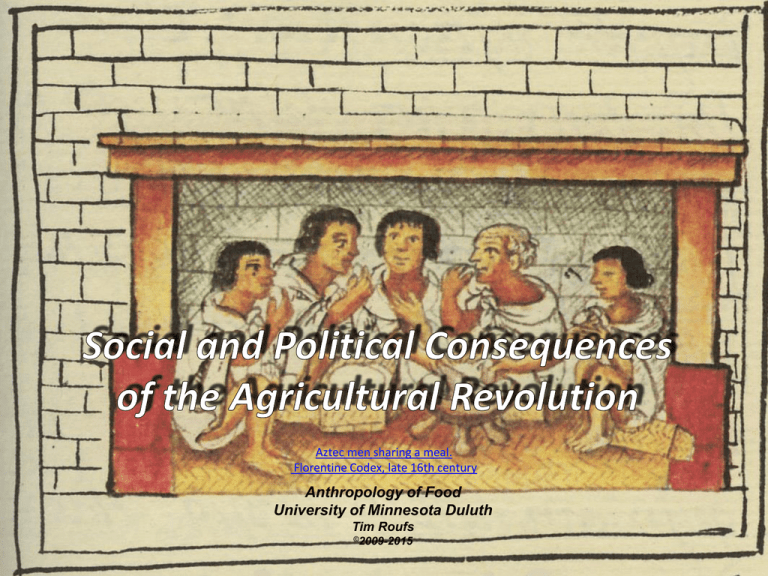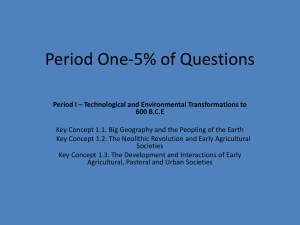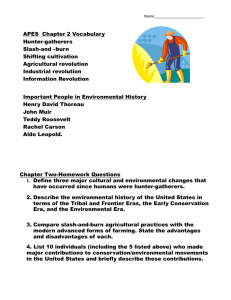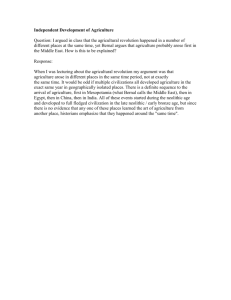Anthropology of Food University of Minnesota Duluth Tim Roufs
advertisement

Aztec men sharing a meal. Florentine Codex, late 16th century Anthropology of Food University of Minnesota Duluth Tim Roufs ©2009-2015 this is a major work on the social, political, and nutritional consequences of “The Agricultural Revolution” . . . and it’s a very good read NY: Random House, 2010 and Reay Tannahill’s work is also excellent . . . Reay Tannahill, (NY: Three Rivers Press, 1988) Food in Historical Perspective: Dietary Revolutions Food in Historical Perspective: Dietary Revolutions • The Agricultural Revolution of the Neolithic Era • The Search for Spices • Development of Agriculture in the Tehuacán Valley • Nutritional • The Industrial Consequences Revolution of the Agricultural Revolution: A Comparison of Foragers and • Transportation, Refrigeration, and Canning Agriculturalists • The Scientific Revolution • Social and Political Consequences • Modern-Day Adaptations of the Agricultural Revolution • Summary • Highlight: Vegetarian Diets: Then and Now the far-reaching consequences of food production began with the “Neolithic Revolution” aka outside of the Near East as the “Agricultural Revolution” Time line for Ch.16 "Food Production” Understanding Physical Anthropology and Archaeology, 9th Ed., p. 333 as a result of the Agricultural Revolution people began to have and see . . . • • • • • • • • • • • • • surplus food trade and trade networks specialization of production specialized laborers increased social interaction food storage for times of shortage surplus is “taxed” monumental architecture competition for limited resources private property class systems organized governments (political / religious / military hierarchies) and the list goes on . . . as a result of the Agricultural Revolution people began to have and see . . . • surplus food promotes cultural change • • • • • • • • • • • • trade and trade networks specialization of production specialized laborers increased social interaction food storage for times of shortage surplus is “taxed” monumental architecture competition for limited resources private property class systems organized governments (political / religious / military hierarchies) and the list goes on . . . Social and Political Consequences of the Agricultural Revolution surplus food • fostered trade with people in other ecological zones • allowed access to previously unknown commodities • for the first time in history not everyone had to be involved in food-getting activities The Cultural Feast, 2nd Ed., p. 55 Social and Political Consequences of the Agricultural Revolution surplus food • fostered trade with people in other ecological zones • allowed access to previously unknown commodities • for the first time in history not everyone had to be involved in food-getting activities The Cultural Feast, 2nd Ed., p. 55 diffusion occurred from all of the centers of agricultural domestication “A dialectical model of Neolithic Origins” www.archatlas.dept.shef.ac.uk/OriginsFarming/Farming.php and the maize, beans, squash, chili “complex” spread throughout much of North and northern South America . . . maize manioc potatoes, sweet potatoes, yams beans peanuts squash in prehistoric America, for e.g., various regions began to have new foods from other regions, and after contact with Europeans their foods were even more widely traded (throughout most of the world), and, in come cases, becoming central to the cuisines of other cultures . . . pineapples avocados tomatoes chocolate vanilla chili America’s First Cuisines, Chs. 2 and 3 maize manioc potatoes, sweet potatoes, yams beans peanuts squash in prehistoric America, for e.g., various regions began to have new foods from other regions, and after contact with Europeans their foods were even more widely traded (throughout most of the world), and, in come cases, becoming central to the cuisines of other cultures . . . it’s difficult, for e.g., to even imagine Italian food without tomatoes pineapples avocados tomatoes chocolate vanilla chili America’s First Cuisines, Chs. 2 and 3 • barter and exchange flourished • new social order distinguished landowners and tenant farmers Eight Food “Revolutions” 1. Invention of Cooking 2. Discovery that Food is More Than Sustenance 3. The “Herding Revolution” 4. Snail Farming 5. Use of Food as a Means and Index of Social Differentiation 6. Long-Range Exchange of Culture 7. Ecological Revolution of last 500 years 8. Industrial Revolution of the 19th and 20th Centuries Simon & Schuster 2003 Aztec Pochteca, for e.g., travelled far and wide (professional long-distance traveling merchants) Florentine Codex late 16th century as a result of the Agricultural Revolution people began to have and see . . . • surplus food • trade and trade networks developed • • • • • • • • • • • specialization of production specialized laborers increased social interaction food storage for times of shortage surplus is “taxed” monumental architecture competition for limited resources private property class systems organized governments (political / religious / military hierarchies) and the list goes on . . . Maya trade Bonampak Pueblo Bonito New Mexico Village farming cultures of the American Southwest, showing trade routes (red) Understanding Physical Anthropology and Archaeology, 9th Ed., p. 359 Obsidian trade 4th millennium B.C. http://commons.wikimedia.org/wiki/File:Obsidian_trade_%28IV_millenium_BC%29.png http://www.pakistanpatriot.com/?tag=moenjodaro http://www.geo.msu.edu/geogmich/ojibwe.html Social and Political Consequences of the Agricultural Revolution • some people also succeeded in trade and the acquisition of surplus wealth • giving rise in many places to an affluent and powerful merchant class The Cultural Feast, 2nd Ed., p. 55 A group portrait of three sons of William Money (1738–96), an early director of the East India Company. Left to right: Robert (1775–1803), William (1769–1834), and James (1772–1833) (1788–92) [▼]John Francis Rigaud (1742–1810) http://ocw.mit.edu/ans7870/21f/21f.027/rise_fall_canton_04/gallery_people/pages/cwPT_1788-92_nmm_BHC2866.htm • barter and exchange flourished • new social order distinguished landowners and tenant farmers . . . "Peasant Woman with Buckets and Child" (1912) Kazimir Malevich (1878-1935) http://max.mmlc.northwestern.edu/~mdenner/Drama/visualarts/avant-garde/peasant_women14.html “Farmer Codex: In the Aztec world, the majority of people were farmers such as this man, harvesting his crop.” Florentine Codex, Vol. 4, Folia 73L http://museumanthropology.blogspot.com/2008/07/aztec-world-exhibition-at-field-museum.html • barter and exchange flourished • new social order distinguished landowners and tenant farmers . . . and eventually masters were distinguished from servants and slaves . . . Funerary stele of Mnesarete a young servant (left) is facing her dead mistress Attica circa 380 B.C. (Glyptothek, Munich, Germany) http://museumanthropology.blogspot.com/2008/07/aztec-world-exhibition-at-field-museum.html Le marché aux esclaves (The Slave Market) before 1882 Gustave Clarence Rodolphe Boulanger (1824-1888) http://commons.wikimedia.org/wiki/File:Boulanger_Gustave_Clarence_Rudolphe_The_Slave_Market.jpg I supplicanti. Espulsione dei Gitanos dalla Spagna 1872 Edwin Longsden Long http://commons.wikimedia.org/wiki/File:Supplicants_expulsion_gypsies_hi.jpg Social and Political Consequences of the Agricultural Revolution • surplus food • fostered trade with people in other ecological zones • allowed access to previously unknown commodities • for the first time in history not everyone had to be involved in food-getting activities The Cultural Feast, 2nd Ed., p. 55 as a result of the Agricultural Revolution people began to have and see . . . • surplus food • trade and trade networks • specialization of production and • specialized laborers appeared • • • • • • • • • increased social interaction food storage for times of shortage surplus is “taxed” monumental architecture competition for limited resources private property class systems organized governments (political / religious / military hierarchies) and the list goes on . . . non-farmers could engage in specialized gathering activities . . . Aztecs Fishing Florentine Codex late 16th century non-farmers could even specialize in gathering just one thing . . . and non-farmers could engage in specialized crafts . . . Social and Political Consequences of the Agricultural Revolution • people began to master crafts like . . . •basket making • • • • • ceramics bronze and metal casting brick making masonry other skills The Cultural Feast, 2nd Ed., p. 55 economic system allows individuals to devote full time to occupations like . . . basket making Prehistoric basketry techniques (Jean Connor) Pima baskets, photographed around 1907 by Edward S. Curtis http://en.wikipedia.org/wiki/File:Pima_baskets.jpg Social and Political Consequences of the Agricultural Revolution • people began to master crafts like . . . • basket making •ceramics • • • • bronze and metal casting brick making masonry other skills The Cultural Feast, 2nd Ed., p. 55 you saw the importance of pottery and pottery analysis in the “Chocolate” Forum you saw the importance of pottery and pottery analysis in the “Chocolate” Forum http://news.nationalgeographic.com/news/bigphotos/10056647.html the “Pre-pottery” and “Pottery” stages in fact define the Neolithic, with pottery developing by about 5500 B.C. . . . http://en.wikipedia.org/wiki/History_of_pottery_in_the_Southern_Levant#Pre-pottery_Neolithic_.28ca._8300.E2.80.93_ca._5500_BC.29 pottery in the Neolithic develops by about 5500 B.C. . . . http://en.wikipedia.org/wiki/History_of_pottery_in_the_Southern_Levant#Pre-pottery_Neolithic_.28ca._8300.E2.80.93_ca._5500_BC.29 Biocultural Consequences: Technology • basket and skin containers were replaced with ceramic vessels • baskets were likely lined with clay, and eventually fired • fire pits likely naturally were fired as part of the cooking process Biocultural Consequences: Technology • pottery made it easier to prepare and boil grains into digestible foods Biocultural Consequences: Technology • pottery made it easier to prepare and boil grains into digestible foods and in Europe, for e.g., up until relatively recent times grains — a primary food since the Neolithic Revolution — were probably eaten as a form of porridge or gruel by everyone except the upper class . . . pottery appears in the 16th century Spanish manuscripts . . . Aztec woman preparing tortillas — pottery jar . . . Codex Mendoza, folio 60r pottery appears in the 16th century Spanish manuscripts . . . Aztec woman preparing tortillas — comal(li) . . Codex Mendoza, folio 60r The three hearthstones support the traditional ceramic comal(li) Codex Mendoza, folio 60r the comal is a flat pre-Conquest pottery griddle . . . the likes of which are still used in Mesoamerica today . . . economic system allows individuals to devote full time to occupations like . . . pottery making Classic Maya cylindrical jar with bird motif and glyphs, Understanding Physical Anthropology and Archaeology, 9th Ed., p. 411 prehistoric decorated pottery vessel from Arizona Understanding Physical Anthropology and Archaeology, 9th Ed., p. 365 Decorated predynastic pottery jar, Nile valley, Egypt Understanding Physical Anthropology and Archaeology, 9th Ed., p. 461 bandkeramic – “lined pottery," referring to a Neolithic ceramic ware widely encountered in central Europe and to the culture that produced it Understanding Physical Anthropology and Archaeology, 8th Ed., p. 427 “seriation” a “seriation graph” shows the evolution of pottery types from Deh Luran, Iran Hole, Flannery and Neely, “Prehistory and Human Ecology Of the Deh Luran Plain: An Early Village Sequence from Khuzistan, Iran.” Ann Arbor: 1969, fig. 69 Social and Political Consequences of the Agricultural Revolution • people began to master crafts like . . . • ceramics • bronze and metal casting appear • brick making • masonry • other skills The Cultural Feast, 2nd Ed., p. 55 Bronze Age – period of early Old World civilizations associated with the widespread use of metal tools after 5,500 ybp Cast bronze ritual vessel of the Shang dynasty, China Understanding Physical Anthropology and Archaeology, 9th Ed., p 468 Copper Age "Ötzi“ “The Iceman” about 5,300 ybp Wikipedia Mycenaean Bronze Age axe, or winged palstave Understanding Physical Anthropology and Archaeology, 8th Ed., p. 473 economic system allows individuals to devote full time to occupations like . . . metalworking Inca gold and these objects become an important part of the developing trading networks Inca gold artifact in the Central Bank Museum, Quito, Ecuador © D. Donne Bryant as a result of the Agricultural Revolution people began to have and see . . . • • • • surplus food trade and trade networks specialization of production specialized laborers • increased social interaction develops • • • • • • • • food storage for times of shortage surplus is “taxed” monumental architecture competition for limited resources private property class systems organized governments (political / religious / military hierarchies) and the list goes on . . . Social and Political Consequences of the Agricultural Revolution • population growth • the establishment of large, sedentary villages provides . . . • the opportunity for increased social interaction • but with added health risks The Cultural Feast, 2nd Ed., p. 55 "Community Life“ at Cahokia Michael Hampshire Cahokia Mounds State Historic Site Collinsville, Illinois as a result of the Agricultural Revolution people began to have and see . . . • • • • • surplus food trade and trade networks specialization of production specialized laborers increased social interaction • food storage for times of shortage appears • • • • • • • surplus is “taxed” monumental architecture competition for limited resources private property class systems organized governments (political / religious / military hierarchies) and the list goes on . . . Social and Political Consequences of the Agricultural Revolution • surplus food • food surplus could be used in times of shortages The Cultural Feast, 2nd Ed., p. 55 some of these are very well known Joseph interprets the dream of the Pharaoh Painting by Peter von Cornelius http://en.wikipedia.org/wiki/Joseph_(Hebrew_Bible) Seven Years of Plenty, Seven Years of Famine www.mycatholictradition.com/saints-of-old-joseph2.html and some have been going on “forever,” like the storing the annual maize crop Hidalgo, Mexico and some have been going on “forever,” like the storing the annual maize crop (in the backyard) Hidalgo, Mexico Grain storage structure and clay pots, southeast Sénégal (west Africa) Large Grain Storage Jar (Mohen-jo-daro, India) http://homepage.ntlworld.com/myjamro/sindh/sindh_history/mohen-jo-daro_civil_engineering_wonder.htm http://fanaticcook.blogspot.com/2009/07/prehistoric-granaries-humans-have-been.html http://fanaticcook.blogspot.com/2009/07/prehistoric-granaries-humans-have-been.html http://fanaticcook.blogspot.com/2009/07/prehistoric-granaries-humans-have-been.html www.freebuck.com/articles/elliott/00elliottfoundations.htm Aztecs Storing Maize Florentine Codex late 16th century as a result of the Agricultural Revolution people began to have and see . . . • • • • • • surplus food trade and trade networks specialization of production specialized laborers increased social interaction food storage for times of shortage • surplus is “taxed” • • • • • • monumental architecture competition for limited resources private property class systems organized governments (political / religious / military hierarchies) and the list goes on . . . Social and Political Consequences of the Agricultural Revolution • surplus food • and “collecting” the tax and keeping track of crop exchanges led to early forms and eventual development of writing . . . The Cultural Feast, 2nd Ed., p. 55 Ten Classic Characteristics of Early Civilization 2. Social means of collecting “surplus” production Small Sumerian clay table is a 4,000-year-old tax receipt with cuneiform impressions on both sides Understanding Physical Anthropology and Archaeology, 9th Ed., p. 389 “Roman writing tablet from the Vindolanda Roman fort of Hadrian's Wall, in Northumberland (1st — 2nd century A.D.) requesting money to buy 5,000 measures of cereal used for brewing beer” Department of Prehistory and Europe, British Museum http://en.wikipedia.org/wiki/Accounting#Token_accounting_in_ancient_Mesopotamia Social and Political Consequences of the Agricultural Revolution • surplus food • excess production served as capital that fostered new socioeconomic transactions — including barter The Cultural Feast, 2nd Ed., p. 55 http://indopraba.blogspot.com/2009/05/back-to-barter-economy.html "The Barter“ Kibuuka http://www.kibuuka-prints.com/print14.html “This work immortalizes a local village market set in rural Uganda. Evoking a tradition that predates the notion of monetary wealth, goods in abundance are exchanged for those more scarce. These interactions reinforce complex social bonds while they reaffirm one's relationship to the local community and its shared resources.” "The Barter“ Kibuuka http://www.kibuuka-prints.com/print14.html An 1874 newspaper illustration from Harper's Weekly, showing a man engaging in barter: offering chickens in exchange for his yearly newspaper subscription http://en.wikipedia.org/wiki/Barter as a result of the Agricultural Revolution people began to have and see . . . • • • • • • • • surplus food trade and trade networks specialization of production specialized laborers increased social interaction food storage for times of shortage surplus is “taxed” monumental architecture • competition for limited resources developed • • • • private property class systems organized governments (political / religious / military hierarchies) and the list goes on . . . Social and Political Consequences of the Agricultural Revolution • as population increased • competition for limited resources occurred . . . for . . . • water • land • other basic resources The Cultural Feast, 2nd Ed., p. 55 Social and Political Consequences of the Agricultural Revolution • as population increased • competition for limited resources occurred . . . for . . . •water • land • other basic resources The Cultural Feast, 2nd Ed., p. 55 NY: Bloomsbury ( 2009) http://en.wikipedia.org/wiki/Barter Social and Political Consequences of the Agricultural Revolution • as population increased • competition for limited resources occurred . . . for . . . • water •land • other basic resources The Cultural Feast, 2nd Ed., p. 55 http://news.bbc.co.uk/2/hi/americas/8600353.stm Social and Political Consequences of the Agricultural Revolution • as population increased • competition for limited resources occurred . . . for . . . • water • land •other basic resources The Cultural Feast, 2nd Ed., p. 55 http://news.bbc.co.uk/panorama/hi/front_page/newsid_8523000/8523999.stm Social and Political Consequences of the Agricultural Revolution • political / religious / military hierarchies took over the tasks of . . . • organizing production • maintaining order in an increasingly complex society • defending the community The Cultural Feast, 2nd Ed., pp. 55-56 Social and Political Consequences of the Agricultural Revolution • political / religious / military hierarchies took over the tasks of . . . • and this led to the rise of states and empires . . . The Cultural Feast, 2nd Ed., pp. 55-56 Social and Political Consequences of the Agricultural Revolution • political / religious / military hierarchies took over the tasks of . . . • and this led to the rise of states and empires . . . James A. Michener says there were about 75 major civilizations in the “history” of the world (with a typical rise-fall cycle of 200 – 400 years, with the “fall” often related to food production and distribution) The Cultural Feast, 2nd Ed., pp. 55-56 Social and Political Consequences of the Agricultural Revolution • states and empires began to have . . . • specialized laborers • private property • class systems • organized governments The Cultural Feast, 2nd Ed., p. 56 Social and Political Consequences of the Agricultural Revolution • states and empires began to have . . . • specialized laborers • private property •class systems • organized governments The Cultural Feast, 2nd Ed., p. 56 as a result of the Agricultural Revolution people began to have and see . . . • • • • • • • • • • surplus food trade and trade networks specialization of production specialized laborers increased social interaction food storage for times of shortage surplus is “taxed” monumental architecture competition for limited resources private property • class systems develop • organized governments (political / religious / military hierarchies) • and the list goes on . . . Social and Political Consequences of the Agricultural Revolution • people became divided for the first time into . . . • priests, warriors, and artisans groups • rich and poor • upper and lower classes • rulers and ruled • master and slave The Cultural Feast, 2nd Ed., p. 56 REM Eight Food “Revolutions” 1. Invention of Cooking 2. Discovery that Food is More Than Sustenance 3. The “Herding Revolution” 4. Snail Farming 5. Use of Food as a Means and Index of Social Differentiation 6. Long-Range Exchange of Culture 7. Ecological Revolution of last 500 years 8. Industrial Revolution of the 19th and 20th Centuries Simon & Schuster 2003 Ten Classic Characteristics of Early Civilization 10. A privileged ruling class of religious, political, and military leaders organizes and directs the entire system Hieroglyphic inscription of a royal Egyptian hunting marsh birds from a papyrus boat 9th Ed. p. 393 King Tut King “Tut” www.ctv.ca/servlet/ArticleNews/story/CTVNews/20071104/king_tut_071104/20071104?hub=CTVNewsAt11 Mocezuma II a classic in the Anth of Food is . . . “Montezuma’s Dinner: An Essay on the Tribal Society of the North American Indians” Lewis Henry Morgan NY: Heritage Press 1876 Mocezuma II Aztecs stone altar dedicated to corn Museum of Anthropology Social and Political Consequences of the Agricultural Revolution with social stratification heterogeneous diets appeared . . . • not everyone who lived in the same area ate similar foods Social and Political Consequences of the Agricultural Revolution with social stratification heterogeneous diets appeared . . . • not everyone who lived in the same area ate similar foods • food patterns of a region varied considerably among people of different rank or status Social and Political Consequences of the Agricultural Revolution by the end of the 15th century . . . • agriculture had brought cities and complex political systems to most parts of the world • trade networks linked many parts of the world • the age of exploration was about to begin The Cultural Feast, 2nd Ed., p. 56 Social and Political Consequences of the Agricultural Revolution . . . and food played a critical role in the political developments of almost every era from then until present-day . . . The Cultural Feast, 2nd Ed., p. 56 Social and Political Consequences of the Agricultural Revolution have a look at th century . . . by the “The endSearch of the 15 for Spices” and • agriculture had brought cities and “The Scientific Revolution” andsystems to most parts complex political Adaptations” of the“Modern-Day world slide sets . . . trade networks many parts of but• first, speakinglinked of modern-day . .the . world • the age of exploration was about to begin The Cultural Feast, 2nd Ed., p. 56 Social and Political Consequences of the Agricultural Revolution . . . of course . . . the agricultural revolution also played a critical role in the development of modern-day era specialty foods that changed America (and Americans) . . . The Cultural Feast, 2nd Ed., p. 56 http://www.inklingmagazine.com/inkycircus/C26/26/P10/ http://www.lisagriffis.com/2008/11/treat-your-holiday-plate-like-it-was-a-tv-dinner-tray/ http://pro.corbis.com/search/Enlargement.aspx?CID=isg&mediauid=858D8FC4-F6ED-4BA6-A022-765FABA76518 http://www.esquire.com/the-side/feature/worlds-worst-eating-contests-070108 Social and Political Consequences of the Agricultural Revolution . . . and, of course, the agricultural revolution ultimately played a critical role in the development of modern-day era specialty foods that changed America (and Americans) including in Minnesota and Wisconsin . . . Cf., The Cultural Feast, 2nd Ed., p. 56 http://www.hormel.com/ http://www.impactlab.net/2009/08/10/top-10-foods-on-a-stick/ In case you didn’t recognize it, this is Spam on a stick . . . http://www.impactlab.net/2009/08/10/top-10-foods-on-a-stick/ not to be confused with the “Toronto Potato” on a stick . . . http://www.impactlab.net/2009/08/10/top-10-foods-on-a-stick/ and finally, most cultural behaviors associated with food (including drink) can trace their roots all the way back to the Agricultural Revolution of Neolithic times . . . and some, maybe even all the way back before that, to “cave man” days . . . http://ccounty.wordpress.com/category/educational/






